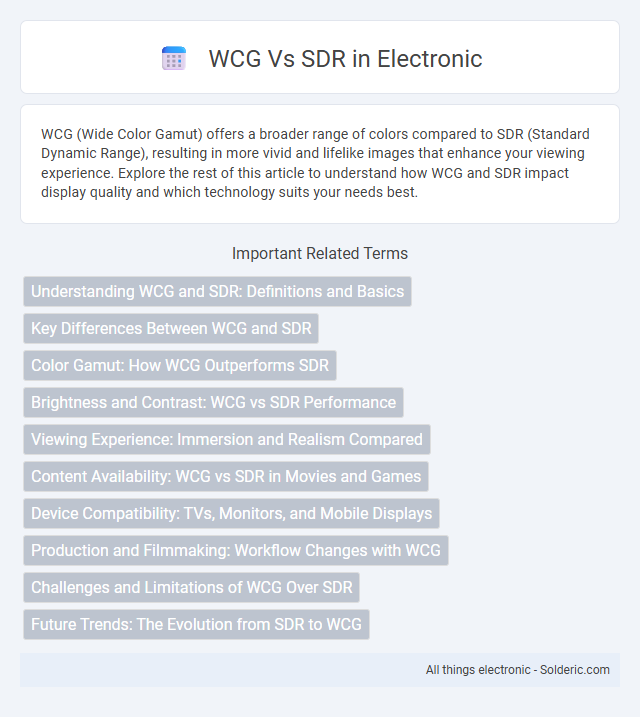WCG (Wide Color Gamut) offers a broader range of colors compared to SDR (Standard Dynamic Range), resulting in more vivid and lifelike images that enhance your viewing experience. Explore the rest of this article to understand how WCG and SDR impact display quality and which technology suits your needs best.
Comparison Table
| Feature | WCG (Wide Color Gamut) | SDR (Standard Dynamic Range) |
|---|---|---|
| Color Range | Expanded color spectrum beyond sRGB | Limited to sRGB or Rec. 709 color space |
| Brightness | Usually supports higher brightness levels | Typically up to 100 nits |
| Contrast | Improved contrast with vivid colors | Standard contrast ratio |
| Usage | Used in HDR content, professional displays, gaming | Common in legacy displays and general content |
| Benefits | Richer colors, enhanced visual experience | Broad compatibility, simpler processing |
Understanding WCG and SDR: Definitions and Basics
WCG (Wide Color Gamut) refers to a color space that encompasses a broader range of colors than SDR (Standard Dynamic Range), offering more vivid and true-to-life visuals. SDR represents the traditional color and brightness standards used in most displays, with limited color depth and contrast compared to WCG. Understanding the differences between WCG and SDR helps you choose displays or content that deliver richer hues and enhanced visual experiences.
Key Differences Between WCG and SDR
WCG (Wide Color Gamut) offers a broader spectrum of colors compared to SDR (Standard Dynamic Range), enhancing color richness and accuracy in images and videos. SDR typically covers smaller color spaces like Rec. 709, while WCG supports extended gamuts such as DCI-P3 and Rec. 2020, delivering more vibrant visuals. Understanding these differences helps you choose display technology that best suits your needs for color precision in media consumption or production.
Color Gamut: How WCG Outperforms SDR
WCG (Wide Color Gamut) displays a significantly broader range of colors compared to SDR (Standard Dynamic Range), covering up to 90% of the DCI-P3 color space, while SDR is limited to the narrower Rec. 709 spectrum. This expanded color gamut enables WCG to render more vibrant and lifelike hues, enhancing visual realism and immersion. Your viewing experience is enriched with richer greens, deeper reds, and more nuanced blues, providing a superior color depth unavailable in SDR content.
Brightness and Contrast: WCG vs SDR Performance
Wide Color Gamut (WCG) displays offer significantly higher brightness levels and enhanced contrast ratios compared to Standard Dynamic Range (SDR) screens, delivering more vivid and lifelike images. WCG technology expands the range of colors and luminance, allowing your visuals to showcase deeper blacks and brighter highlights that SDR cannot achieve. This improvement in brightness and contrast ensures a more immersive viewing experience, especially in scenes with high dynamic range elements.
Viewing Experience: Immersion and Realism Compared
WCG (Wide Color Gamut) significantly enhances the viewing experience by delivering richer, more vibrant colors that closely mirror real-life scenes, unlike SDR (Standard Dynamic Range) which offers a narrower color spectrum. This expanded color range in WCG contributes to greater immersion and realism, making visuals appear more lifelike and engaging. Your content will benefit from the depth and nuance WCG provides, creating a more captivating and true-to-life viewing environment.
Content Availability: WCG vs SDR in Movies and Games
WCG (Wide Color Gamut) offers significantly enhanced content availability in movies and games compared to SDR (Standard Dynamic Range), delivering richer and more vibrant colors that closely match real-world visuals. Hollywood studios and game developers increasingly support WCG formats such as DCI-P3 and Rec. 2020, enabling more immersive viewing experiences with deeper reds, greens, and blues. SDR content remains prevalent but is gradually being surpassed by WCG-enabled media as consumer displays and streaming platforms adopt advanced color standards.
Device Compatibility: TVs, Monitors, and Mobile Displays
Wide Color Gamut (WCG) technology enhances device compatibility by delivering richer and more vibrant colors across TVs, monitors, and mobile displays, supporting standards like DCI-P3 and Rec. 2020 for improved color accuracy. Standard Dynamic Range (SDR) devices typically cover the more limited Rec. 709 color space, resulting in less vivid and diverse color reproduction. Modern TVs and high-end monitors increasingly incorporate WCG support to match the enhanced color capabilities of mobile displays, ensuring a consistent and immersive viewing experience across all platforms.
Production and Filmmaking: Workflow Changes with WCG
Wide Color Gamut (WCG) significantly enhances production and filmmaking workflows by providing a broader range of colors and greater color accuracy than Standard Dynamic Range (SDR). This improvement allows filmmakers to capture and grade footage with more vibrant and realistic colors, ensuring the final output maintains its visual integrity across compatible displays. Your color grading process becomes more nuanced, enabling better creative control and more immersive storytelling through richer visual detail.
Challenges and Limitations of WCG Over SDR
Wide Color Gamut (WCG) technology faces challenges such as higher production costs and limited content availability compared to Standard Dynamic Range (SDR). WCG displays also demand more precise calibration and increased processing power, which can lead to compatibility issues with existing hardware and software. These limitations may affect your viewing experience, especially when WCG content is not fully supported or optimized.
Future Trends: The Evolution from SDR to WCG
The evolution from SDR (Standard Dynamic Range) to WCG (Wide Color Gamut) marks a significant leap in display technology, enhancing color accuracy and richness across devices. Future trends indicate widespread adoption of WCG in consumer electronics, driven by advancements in OLED and QLED panels that support broader color spectrums. Integration of WCG with HDR (High Dynamic Range) standards is expected to become the norm in streaming platforms and gaming, delivering more immersive and lifelike visual experiences.
WCG vs SDR Infographic

 solderic.com
solderic.com